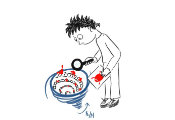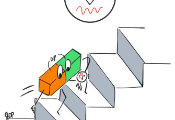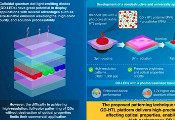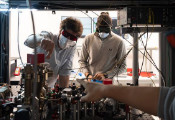Rice Researchers Take ‘Significant Leap Forward’ With Quantum Simulation of Molecular Electron Transfer
December 20, 2024 -- Researchers at Rice University have made a meaningful advance in the simulation of molecular electron transfer — a fundamental process underpinning countless physical, chemical and biological processes. The study, published in Science Advances, details the use of a trapped-ion quantum simulator to model electron transfer dynamics with unprecedented tunability, unlocking new opportunities for scientific exploration in fields ranging from molecular electronics to photosynthesis.
Electron transfer, critical to processes such as cellular respiration and energy harvesting in plants, has long posed challenges to scientists due to the complex quantum interactions involved. Current computational techniques often fall short of capturing the full scope of these processes. The multidisciplinary team at Rice, including physicists, chemists and biologists, addressed these challenges by creating a programmable quantum system capable of independently controlling the key factors in electron transfer: donor-acceptor energy gaps, electronic and vibronic couplings and environmental dissipation.
Using an ion crystal trapped in a vacuum system and manipulated by laser light, the researchers demonstrated the ability to simulate real-time spin dynamics and measure transfer rates across a range of conditions. The findings not only validate key theories of quantum mechanics but also pave the way for novel insights into light-harvesting systems and molecular devices.

“This is the first time that this kind of model was simulated on a physical device while including the role of the environment and even tailoring it in a controlled way,” said lead researcher Guido Pagano, assistant professor of physics and astronomy. “It represents a significant leap forward in our ability to use quantum simulators to investigate models and regimes that are relevant for chemistry and biology. The hope is that by harnessing the power of quantum simulation, we will eventually be able to explore scenarios that are currently inaccessible to classical computational methods.”
The team achieved a significant milestone by successfully replicating a standard model of molecular electron transfer using a programmable quantum platform. Through the precise engineering of tunable dissipation, the researchers explored both adiabatic and nonadiabatic regimes of electron transfer, demonstrating how these quantum effects operate under varying conditions. Additionally, their simulations identified optimal conditions for electron transfer, which parallel the energy transport mechanisms observed in natural photosynthetic systems.
“Our work is driven by the question: Can quantum hardware be used to directly simulate chemical dynamics?” Pagano said. “Specifically, can we incorporate environmental effects into these simulations as they play a crucial role in processes essential to life such as photosynthesis and electron transfer in biomolecules? Addressing this question is significant as the ability to directly simulate electron transfer in biomolecules could provide valuable insights for designing new light-harvesting materials.”
The implications for practical applications are far-reaching. Understanding electron transfer processes at this level could lead to breakthroughs in renewable energy technologies, molecular electronics and even the development of new materials for quantum computing.
“This experiment is a promising first step to gain a deeper understanding of how quantum effects influence energy transport, particularly in biological systems like photosynthetic complexes,” said Jose N. Onuchic, study co-author, the Harry C. and Olga K. Wiess Chair of Physics and professor of physics and astronomy, chemistry and biosciences. “The insights we gain in this type of experiment could inspire the design of more efficient light-harvesting materials.”
Peter G. Wolynes, study co-author, the D.R. Bullard-Welch Foundation Professor of Science and professor of chemistry, biosciences and physics and astronomy, emphasized the broader significance of the findings: “This research bridges the gap between theoretical predictions and experimental verification, offering an exquisitely tunable framework for exploring quantum processes in complex systems.”
The team plans to extend its simulations to include more complex molecular systems such as those involved in photosynthesis and DNA charge transport. The researchers also hope to investigate the role of quantum coherence and delocalization in energy transfer, leveraging the unique capabilities of their quantum platform.
“This is just the beginning,” said Han Pu, co-lead author of the study and professor of physics and astronomy. “We are excited to explore how this technology can help unravel the quantum mysteries of life and beyond.”




































